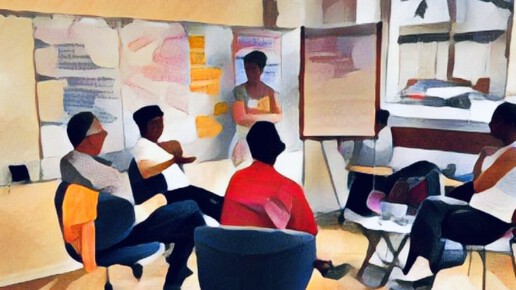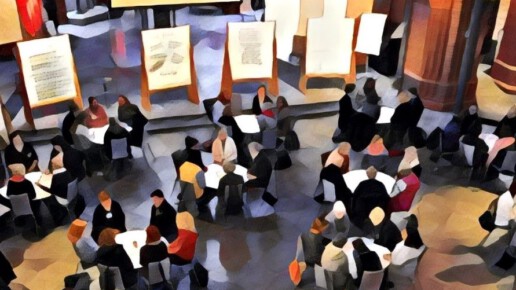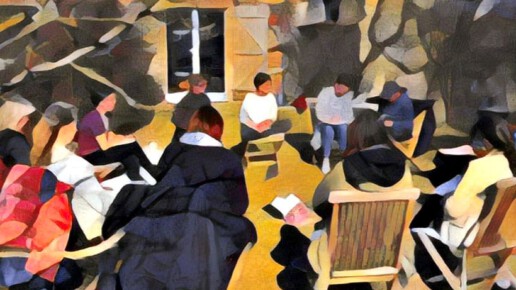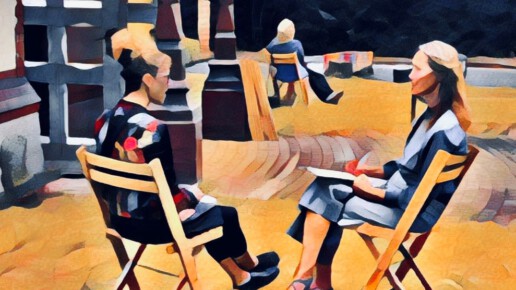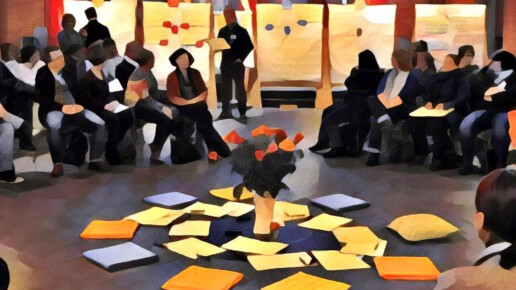***English version see below ***
6 Komplexität adäquat begegnen Meine Grundsätze des #Facilitation, 6 von 8
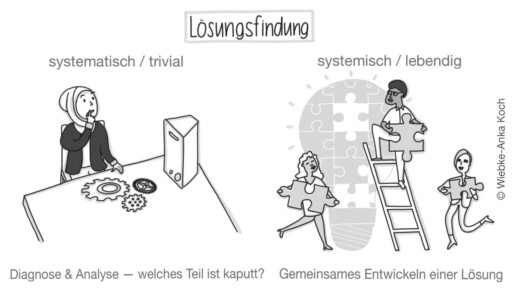
Wenn eine Maschine kaputtgeht, liegt es meist an einem Teil, welches seine Funktion aufgegeben hat. Dann gilt es, das fehlerhafte Teil zu finden und es zu reparieren. In lebendigen Systemen ist diese Diagnose meist irreführend oder schlicht unmöglich. Viel zu komplex und interdependent sind die Strukturen und Prozesse – auch in der Medizin liegt hier oft ein Fehler im System …
Bei der Suche nach neuen Ansätzen oder Lösungen für komplexe Fragestellungen in Gruppen ist offensichtlich der gemeinsame Prozess gefragt. Dies ist meist auch der Anlass für die Zusammenarbeit mit einem Facilitator. Wie der Raum für diesen Prozess gestaltet wird, bestimmt in einem hohen Maße, ob die Gruppe als solche von der Unterschiedlichkeit der einzelnen Elemente profitieren kann oder nicht.
Komplizierte und komplexe Situationen sind meist der Ausgangspunkt für facilitativ begleitete Prozesse. Als Instrument im Workshop kann hier gut die auf der Stacey-Matrix aufbauende Liberating Structure »Agreement and Certainty Matrix« (https://www.liberatingstructures.de/agreement-certainty-matrix/) angewandt werden, um gemeinsam in der Gruppe Herausforderungen einzuordnen und ein Verständnis für die angemessene Methodik der Problemlösung zu erlangen.
In der Bearbeitung komplexer Fragestellungen oder chaotischer Prozesse liegt die Kunst darin, abzuwarten, bis eine Lösung oder ein nächster Schritt klar wird. Sam Kaner (https://communityatwork.com und Kaner 2014) beschreibt partizipative Entscheidungsprozesse in Gruppen mit dem grundlegenden Modell des »Partizipationsdiamanten«. Den gewohnten Gang gehen bedeutet hier, nach einer kurzen Divergenz (zum Beispiel Ideen sammeln) schnell Entscheidungen zu treffen. Ein Prozess jedoch, der Komplexität zulässt und zu einer gemeinsamen Entscheidung führt, geht zwangsläufig durch eine »Knirschzone« (Groan Zone), in der Unbehagen und Spannung auszuhalten sind.
Zu ermöglichen, dass eine Gruppe diese Zone nicht nur so gut wie möglich übersteht, sondern in ihr Neues lernt – das ist unsere Hauptaufgabe. Hier setzen alle zentralen facilitativen Techniken und Ansätze dieses Buches an.
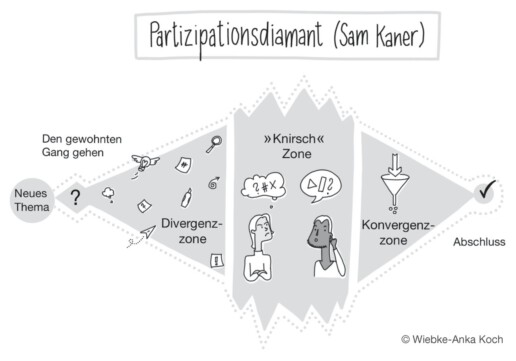
Eine der Methoden, die wir nutzen, wenn eine Situation verfahren ist und es viele verschiedene Perspektiven auf ein wichtiges Thema gibt, ist Dynamic Facilitation.
Dynamic Facilitation ist dann besonders geeignet, wenn eine Gruppe vor einem komplexen Problem steht, es keine einfachen Lösungen gibt und in der Gruppe Meinungsverschiedenheiten, Spannungen oder Konflikte existieren. Im Kern geht es darum, Wahlmöglichkeiten in der Gruppe zu schaffen, Informationen zu sammeln und eine Lösung so lange in der Schwebe zu halten, bis sie sich buchstäblich durchbruchsartig im Raum manifestiert. Die Methodik wurde von Jim Rough entwickelt (s. http://www.dynamicfacilitation.com/index.html und zur Bonsen/Zubizarreta 2019) und grenzt sich ab von Diskussion und Debatte, aber auch vom Dialog im Sinne von David Bohm.
Dazu werden alle Aussagen während des gesamten Prozesses vier Kategorien (Listen) zugeordnet:
- Herausforderung: Ausgangssituation oder Erkenntnisse, wie sie sich heute zeigen und wie sie die Teilnehmenden wahrnehmen
- Lösungen oder kreative Beiträge: Möglichkeiten, Alternativen, Chancen oder Hilfen, die Teilnehmende einbringen
- Befürchtungen oder Bedenken: Befürchtungen oder Einwände, die Teilnehmende äußern. Dazu möglichst keine allgemeinen Bewertungen machen wie »Der Vorschlag ist schlecht«, sondern eher sagen: »Das wird mehr kosten.«
- Informationen oder Sichtweisen: Diese sind hilfreich, um sich jeweils ein genaueres Bild zu machen: zum Beispiel Zahlen, Daten, Fakten, Beispiele oder Äußerungen von Personen, die nicht teilnehmen.
Diese vier Listen werden auf Flipcharts geschrieben, die Teilnehmenden sitzen im Halbkreis davor, der Facilitator oder das Team (ich arbeite damit gern zu zweit) schreibt alles, was gesagt wird, in den Worten der Teilnehmenden auf die Listen. Das Besondere an dieser Methode ist, dass wir die Gruppe nicht dazu auffordern, eine bestimmte Aussage oder Lösung zu erörtern, sondern wir nehmen alles auf und locken somit all das hervor, was gesagt werden will. Meist wird das volle Ausmaß der Komplexität im Rahmen einer anfänglichen »Entleerung« deutlich und es entstehen Spannungen im Raum. In einer meist recht dynamischen Folge von Divergenzen und Konvergenzen, die vom Begleitteam mit Ruhe und Gelassenheit gehalten werden, kann es dann zu einem kreativen Flow, einer Übereinkunft oder einem »Durchbruch« kommen, der für die meisten Teilnehmenden überraschend und neu ist.
In unserer Praxis nutzen wir darüber hinaus alle offenen, dialogfördernden Methoden sowie Großgruppenformate, um komplexe Situationen zu bearbeiten. Darüber mehr in den folgenden Buchteilen.
______________
Mehr zu den Grundsätzen des Facilitation in meinem „Mini Handbuch Facilitation“, Beltz-Verlag 2021, oder in unseren Ausbildungsangeboten auf www.facilitation-academy.de
Wir möchten besonders auf unsere folgenden Ausbildungsangebote hinweisen:
1-jährige Ausbildung zum Facilitator
Seminar Interne Prozessbegleitung
Facilitation Basics Online
© Jutta Weimar – Dieser Text ist urheberrechtlich geschützt. Leicht veränderter Auszug aus dem Buch „Mini-Handbuch Facilitation“, erschienen 2021 beim Beltz Verlag. Alle Rechte vorbehalten. Mehr Informationen zu Facilitation unter: www.facilitation-academy.de
*** English version ***
6 Deal with complexity adequatelyMy principles of #Facilitation 6 of 8
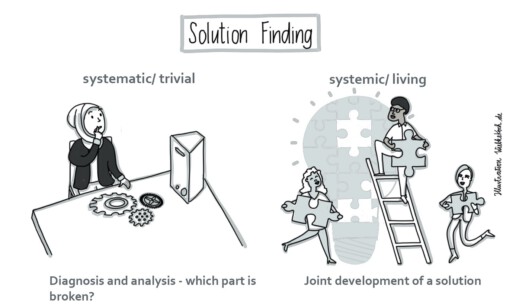
When a machine breaks down, it is usually due to a part that has given up its function. Then the task is to find the faulty part and repair it. In living systems, this diagnosis is usually misleading or simply impossible. The structures and processes are far too complex and interdependent – even in medicine, there is often a fault in the system …
In the search for new approaches or solutions to complex problems in groups, the joint process is obviously in demand. This is usually also the reason for working with a facilitator. The way how the space for this process is designed determines to a large extent whether the group as such can benefit from the diversity of the individual elements or not.
Complicated and complex situations are usually the starting point for facilitative processes. As an instrument in the workshop, the Liberating Structure „Agreement and Certainty Matrix“ (https://www.liberatingstructures.de/agreement-certainty-matrix/), which is based on the Stacey Matrix, can be used well here to classify challenges together in the group and to gain an understanding of the appropriate methodology for problem solving.
In working through complex issues or chaotic processes, the trick is to wait until a solution or next step becomes clear. Sam Kaner (https://communityatwork.com and Kaner 2014) describes participatory decision-making processes in groups using the basic „participation diamond“ model. Going through the usual motions means making decisions quickly after a brief divergence (gathering ideas, for example). However, a process that allows for complexity and leads to a shared decision inevitably goes through a „grind zone“ (groan zone) where discomfort and tension must be endured.
Facilitating a group to not only survive this zone as well as possible, but to learn something new in it – that is our main task. This is where all the key facilitative techniques and approaches come in.
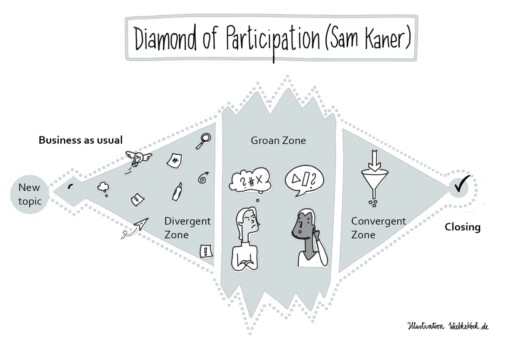
One of the methods we use when a situation is messy and there are many different perspectives on an important issue, is Dynamic Facilitation.
Dynamic Facilitation is particularly appropriate when a group faces a complex problem, when there are no easy solutions and there is disagreement, tension or conflict in the group. At its core, it involves creating choices in the group, gathering information and holding a solution in abeyance until it literally manifests itself breakthrough-like in the room. The methodology was developed by Jim Rough (see http://www.dynamicfacilitation.com/index.html and zur Bonsen/Zubizarreta 2019) and is distinct from discussion and debate, but also from dialogue in the sense of David Bohm.
To this end, all statements throughout the process are assigned to four categories (lists):
– Challenge: initial situation or findings as they appear today and as perceived by the participants.
– Solutions or creative contributions: Possibilities, alternatives, opportunities or help that participants contribute
– Fears or concerns: Fears or objections that participants express. To this end, if possible, do not make general assessments such as „The proposal is bad,“ but rather say, „It will cost more.“
– Information or points of view: These are helpful to get a more accurate picture of each: for example, numbers, dates, facts, examples or statements from people who are not participating.
These four lists are written on flipcharts, the participants sit in a semicircle in front of them, the facilitator or the team (I like to work with this in pairs) writes everything that is said on the lists in the words of the participants. What is special about this method is, that we do not ask the group to discuss a particular statement or solution, but we rather record everything and thus elicit all that wants to be said. Usually, the full extent of the complexity becomes apparent during an initial „deflation“ and tensions arise in the room. In what is usually a quite dynamic sequence of divergences and convergences, held with calm and composure by the facilitating team, a creative flow, agreement or „breakthrough“ can then occur which appears to be surprising and new to most participants.
In our practice, we also use all open, dialogue-promoting methods as well as large group formats to work through complex situations.
__________________
More about the principles and practice of facilitation in my „Mini Handbuch Facilitation“, published 2021 by Beltz-Verlag, or in our training offers on www.facilitation-academy.de
Join us in our Facilitation Trainings (in German):
1 year Facilitation Training
Inhouse Facilitator
Facilitation Basics Online


